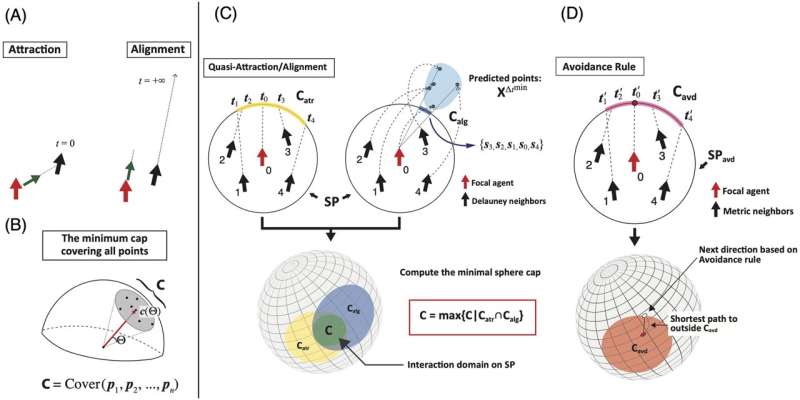This article has been reviewed according to Science X's editorial process and policies. Editors have highlighted the following attributes while ensuring the content's credibility:
fact-checked
peer-reviewed publication
trusted source
proofread
Collective behavior study examines how birds of a feather flock together

Researchers from the Faculty of Engineering, Information, and Systems at the University of Tsukuba used a computer simulation of flocking birds to monitor the flow of information between individuals. They showed that group coordination depends on both the micro- and macro-scale critical dynamics. This work can help provide a framework for better understanding collective behavior without a centralized authority.
Criticality is a feature of some systems that undergo a phase transition, such as ice melting into water. At exactly the critical temperature of zero degrees centigrade, the mixture resembles neither ice nor water, but instead, contains clusters of all different sizes.
This is called "scale-free" behavior and is a hallmark of criticality. Critical phenomena are also common in living systems. When at or near the critical state, information can be transferred efficiently. However, the connections between activities at different scales, and the functional role of group criticality, remain unclear.
Now, researchers at the University of Tsukuba have developed a new computer model of flocking birds. Even though each bird only follows simple rules about remaining close to its neighbors while not colliding, the result is complex flocking behavior. The researchers show that criticality in collective behavior occurs on at least two levels—from the micro- to macro-levels—which they call "nested criticality."
On the micro-scale, each individual bird may use random jaunts of varying lengths, called a Lévy walk, as an optimal search strategy. Zooming out, the macro-scale correlations between clusters of birds with matching directions and speeds can also take on a scale-free character. This means there will be many small clusters, fewer medium clusters, and only a few big clusters.
"Our work highlights the importance for researchers to recognize the role of criticality within a diverse range of situations in order to properly understand them," says first author Professor Takayuki Niizato.
The team used a method that allowed the information flow between two subsystems to be separated into the amount going in each direction, as well as quantifying how much of the information was redundant. The researchers showed that information was moving in both directions between two scale-free subgroups.
This is important because the group turning of a flock of birds has been one of the most debated topics within the field of collective behavior. "Contrary to appearances, the flock does not have a leader-follower information structure. Instead, group coordination is an emergent property of the dynamics," says Professor Niizato.
The findings of this research can be applied to many different biological situations, in which information needs to be rapidly spread without a coordinating executive, as with signals between brain regions.
The work is published in the journal PLOS Computational Biology.
More information: Takayuki Niizato et al, Functional duality in group criticality via ambiguous interactions, PLOS Computational Biology (2023). DOI: 10.1371/journal.pcbi.1010869
Journal information: PLoS Computational Biology
Provided by University of Tsukuba



















